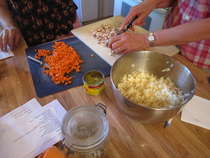 Sister Simone Campbell at the DNC On Wednesday, the Nuns on the Bus arrived at the Democratic National Convention and one of them, Sister Simone Campbell, stood on the podium to remind those with ears to hear that the Romney/Ryan budget “failed a moral test,” echoing the statement of the United States bishops.
Sister Simone Campbell at the DNC On Wednesday, the Nuns on the Bus arrived at the Democratic National Convention and one of them, Sister Simone Campbell, stood on the podium to remind those with ears to hear that the Romney/Ryan budget “failed a moral test,” echoing the statement of the United States bishops.
Sister Simone, executive director of NETWORK, and a group of sisters traveled through nine states, spreading their message of concern about the budget adopted by the Republican party, a budget that would cause great harm to those most vulnerable in our country by cutting funding to programs that provide help to those who need it.
In light of the difficulties between the US Catholic Bishops and the members of the Leadership Council of Women Religious, some might have been surprised to hear Sister Campbell align herself with the bishops at the beginning of her remarks. However, on the issue of the Romney/Ryan budget, they agree. As Sister Campbell explained, despite Congressman Ryan’s claim that “his budget reflects the principles of our shared Catholic faith,” it would hurt those who live in poverty.
She shared poignant stories of individuals she met while on the bus tour: two young boys trying to care for a sick mother, a woman who died of cancer when loss of her job meant loss of health care, a man who depends on food stamps to help feed his family since his employer reduced his hours.
“I am my sister’s keeper. I am my brother’s keeper,” she said.
“Whatever you do to the least of these, you do to me.” Those are Jesus’ words.
 As election day approaches, people of faith, no matter the denomination, have much to consider, including the implications of adoption of the Republican budget that includes huge tax cuts for the wealthiest, repeal of the Affordable Care Act, and budget cuts in programs like food stamps.
As election day approaches, people of faith, no matter the denomination, have much to consider, including the implications of adoption of the Republican budget that includes huge tax cuts for the wealthiest, repeal of the Affordable Care Act, and budget cuts in programs like food stamps.
You can watch a video of Sister Campbell’s remarks here or read the text here. The Catholic News Service April 19, 2012 article, “Letters to Congress: USCCB opposes proposed cuts in services to poor”can be read here.
While thinking them over, you might also think about what is happening in New York, the home turf of another Catholic speaker at the DNC, Archbishop Timothy Cardinal Dolan, president of the USCCB. Despite saying he was not endorsing any candidate while he prayed at both conventions, in his archdiocese, a parish priest reprinted a letter written by six former US ambassadors to the Vatican, encouraging “… our fellow Catholics, and indeed all people of good will, to join with us in this full-hearted effort to elect Governor Mitt Romney as the next President of the United States.”
A petition is making its way around the Internet, asking the archbishop to instruct the priests in his archdiocese to refrain from putting such partisan material in their bulletins. I hope Dolan heeds its message and holds the priests to USCCB’s standard of not endorsing either candidate or party as stated in their booklet, “Faithful Citizenship: A Catholic Call to Political Responsibility”
“Our Church does not offer contributions or endorsements. Instead, we raise a series of questions, seeking to help lift up the moral and human dimensions of the choices facing voters and candidates.”
I am reminded of another person Sister Campbell met while on the bus tour. A thirty-something woman, who felt isolated by the political polarization in her community, asked for names of people she might contact. She longs for people to listen to one another rather than yell. Sister Campbell reassured her that she is not alone.
I know that is true, but the campaign has already been full of vicious attacks and promises to become uglier. Church leaders should be busy about articulating the values that are the foundation of our faith, and trust in the goodness and good sense of the faithful to discern the truth and vote their conscience.


 from the film: “The Intouchables” (Originally published in the Catholic Times, August 26, 2012 © 2012 Mary van Balen)
from the film: “The Intouchables” (Originally published in the Catholic Times, August 26, 2012 © 2012 Mary van Balen) Then there was the Public Marketplace, as noisy and crowded as the garden was quiet and nearly empty. Booth after booth of fresh flowers were a riot of color and reminded me a bit of Thailand markets. Jewelry, clothing, artwork, fruits, vegetables, and yes, the fish market where crabs and whole salmon are tossed about. So NOT Ohio.
Then there was the Public Marketplace, as noisy and crowded as the garden was quiet and nearly empty. Booth after booth of fresh flowers were a riot of color and reminded me a bit of Thailand markets. Jewelry, clothing, artwork, fruits, vegetables, and yes, the fish market where crabs and whole salmon are tossed about. So NOT Ohio.

 I thought about these things as I drove to spend the morning with my sister-in-laws learning to cook a healthy, meatless meal. My sister and I had a great time and eventually brought home some delicious food for dinner. I mentioned Rose of Lima and my discoveries about her.
I thought about these things as I drove to spend the morning with my sister-in-laws learning to cook a healthy, meatless meal. My sister and I had a great time and eventually brought home some delicious food for dinner. I mentioned Rose of Lima and my discoveries about her.  Or maybe working two jobs to make ends meet. Or using the free time economic security provides to volunteer somewhere. It can mean eating less and more healthily (as my morning of cooking prodded me to consider), consuming less material goods. Just allowing oneself times of quiet and prayer can be challenging today.
Or maybe working two jobs to make ends meet. Or using the free time economic security provides to volunteer somewhere. It can mean eating less and more healthily (as my morning of cooking prodded me to consider), consuming less material goods. Just allowing oneself times of quiet and prayer can be challenging today.  “Gratia Plena” by Stephen Heilmer PHOTO: Mary van Balen
“Gratia Plena” by Stephen Heilmer PHOTO: Mary van Balen  Abbot John Klassen OSB PHOTO: Sr. Edith OSB Part Two: “I am doing something NEW….”
Abbot John Klassen OSB PHOTO: Sr. Edith OSB Part Two: “I am doing something NEW….” PHOTO: Mary van Balen No need to remember past events, no need to think about what was done before.
PHOTO: Mary van Balen No need to remember past events, no need to think about what was done before.
 PHOTO:Mary van Balen After a longish day of travel that took me to Seattle via Tennesee, I met my friend Kathryn and her husband Gary for my first experience of Washington state. First impression? Cool, almost cold! Wonderful relief coming from parched midwest. Gary parked the car and we took a walk along Puget Sound until arriving at one of their favorite little seafood diners. All types of seafood was breaded and fried by the owner, an older man who had been running the Sun Fish for quite a few years. Kathryn and Gary had salmon. I tried scallops. Not greasy. Delicious.
PHOTO:Mary van Balen After a longish day of travel that took me to Seattle via Tennesee, I met my friend Kathryn and her husband Gary for my first experience of Washington state. First impression? Cool, almost cold! Wonderful relief coming from parched midwest. Gary parked the car and we took a walk along Puget Sound until arriving at one of their favorite little seafood diners. All types of seafood was breaded and fried by the owner, an older man who had been running the Sun Fish for quite a few years. Kathryn and Gary had salmon. I tried scallops. Not greasy. Delicious.  St. Mark’s Episcopal Cathedral Sunday I attended Mass with Kathryn at the Episcopal Catherdral in Seattle, Saint Marks. The large church building was on its way to becoming a full-fledged gothic cathedral when the depression hit. Years later, the decision was made to leave it as it was and use the millions of dollars completion would have cost for other, more worthy causes. As a result, the church is an interesting mix: Large windows that were to be stained glass, but that are filled with rectangular leaded panes of glass; the rafters can be seen high above where the ceiling would have been; only a few columns have been surrounded with finishing stone. Behind the altar has been ornamented with one of the few additions…a modern glass scultpure filling the space just in front of the plain glassed rose window.
St. Mark’s Episcopal Cathedral Sunday I attended Mass with Kathryn at the Episcopal Catherdral in Seattle, Saint Marks. The large church building was on its way to becoming a full-fledged gothic cathedral when the depression hit. Years later, the decision was made to leave it as it was and use the millions of dollars completion would have cost for other, more worthy causes. As a result, the church is an interesting mix: Large windows that were to be stained glass, but that are filled with rectangular leaded panes of glass; the rafters can be seen high above where the ceiling would have been; only a few columns have been surrounded with finishing stone. Behind the altar has been ornamented with one of the few additions…a modern glass scultpure filling the space just in front of the plain glassed rose window. The day had been long. Work. Haircut. Doctor’s appointment. Late dinner with friends. I had met them at a restaurant I had not been to before and had difficulty finding a parking place downtown. When I returned to my car I found a ticket on the windshield: The spot was in a residential permit area. Sigh. I’m not used to thinking about residential permit areas. Mom’s words came to me: “In a year you’ll never know where that money went. Don’t worry.” Thanks, mom. Worrier extraorinaire over some things, she was right about this one.
The day had been long. Work. Haircut. Doctor’s appointment. Late dinner with friends. I had met them at a restaurant I had not been to before and had difficulty finding a parking place downtown. When I returned to my car I found a ticket on the windshield: The spot was in a residential permit area. Sigh. I’m not used to thinking about residential permit areas. Mom’s words came to me: “In a year you’ll never know where that money went. Don’t worry.” Thanks, mom. Worrier extraorinaire over some things, she was right about this one.